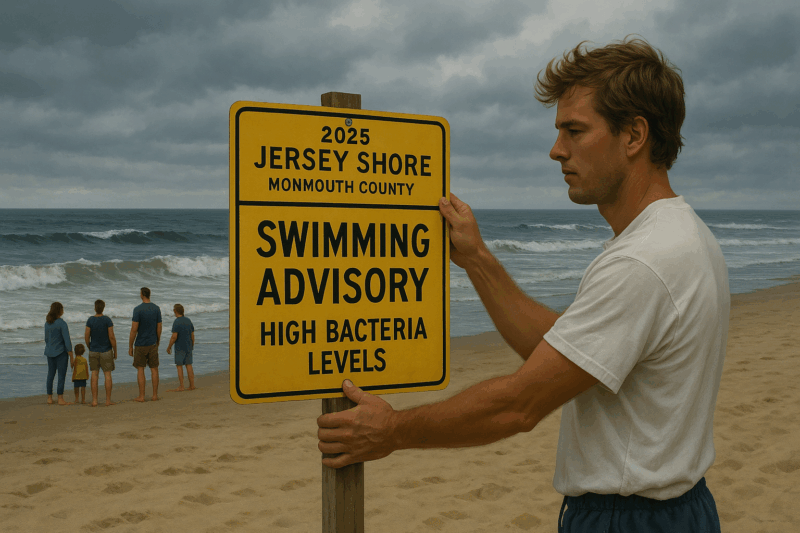On July 23, 2025, three Jersey Shore beaches in Monmouth County were placed under swimming advisories due to elevated levels of fecal bacteria, as reported by NJ.com. This marked a significant improvement from the previous day, when 11 beaches were affected. Additionally, four freshwater lakes in New Jersey remain under similar advisories, and Parvin State Park in Salem County is closed to swimming due to a harmful algal bloom. This article explores the details of the advisories, the causes of the contamination, public health implications, community responses, and the broader societal context of water quality issues at popular recreational sites.
Details of the Swimming Advisories
The New Jersey Department of Environmental Protection (NJDEP) issued advisories for three ocean beaches in Monmouth County on July 23, 2025, after water quality tests revealed enterococci bacteria levels exceeding the safety threshold of 104 colony-forming units per sample. The affected beaches are:
- Spring Lake Borough Ocean Beaches (Brown Ave S and York Ave)
- Atlantic Highlands Borough Bay Beach (Highlands Rec Center)
- Belmar Borough River Beach (L Street Beach)
No beach closures were reported, indicating that bacteria levels, while high, did not yet warrant prohibiting swimming. The NJDEP conducts daily retesting, and a beach will be closed if two consecutive samples exceed the 104-unit threshold until levels drop below the limit.
Additionally, four freshwater lakes are under swimming advisories due to similar bacterial concerns:
- Lake Barnegat – Middle Beach (Lacey Township, Ocean County)
- Harry Wright Lake High Beach (Manchester Township, Ocean County)
- Harry Wright Lake Low Beach (Manchester Township, Ocean County)
- Camp Linwood McDonald (Sandyston Township, Sussex County)
Parvin State Park in Pittsgrove, Salem County, remains closed to swimming due to a harmful algal bloom, a separate environmental issue caused by excessive algae growth, which can produce toxins harmful to humans and animals.
The NJDEP attributes the high bacteria levels to stormwater runoff from recent rainfall, a common cause of fecal contamination in coastal and freshwater bodies. Enterococci, the bacteria monitored, serve as an indicator of potential contamination from human or animal waste, which can pose significant health risks.
Public Health Implications
Swimming in or contacting contaminated water can lead to a range of health issues, as outlined by the NJDEP. Potential symptoms include:
- Gastrointestinal: Nausea, vomiting, diarrhea, and abdominal pain.
- Respiratory: Sore throat, cough, runny nose, and sneezing.
- Eye and Ear: Irritation, earache, and itchiness.
- Dermatological: Skin rashes and itching.
- Flu-like: Fever and chills.
These risks are particularly concerning for vulnerable populations, such as children, the elderly, and those with compromised immune systems. The NJDEP advises residents and visitors to check local beach conditions and follow safety recommendations, such as avoiding swimming during advisories and rinsing off after contact with potentially contaminated water.
Causes and Environmental Context
The primary cause of the elevated bacteria levels is stormwater runoff, which carries pollutants, including fecal matter from animals or failing septic systems, into waterways following heavy rain. New Jersey’s coastal areas, including the Jersey Shore, are particularly susceptible due to their proximity to urban and suburban developments, where runoff can overwhelm drainage systems. A July 2025 NJDEP report noted that 60% of water quality advisories in the state are linked to rainfall events, a trend exacerbated by climate change-driven increases in storm intensity.
Harmful algal blooms, like the one at Parvin State Park, are another growing concern. These blooms, fueled by nutrient pollution (e.g., from fertilizers) and warm temperatures, have increased in frequency across New Jersey, with 15 lake closures reported in 2025 compared to 10 in 2024. The combination of bacterial contamination and algal blooms underscores the broader challenge of maintaining water quality in recreational areas amid environmental changes.
Community and Official Responses
Local officials and beachgoers have expressed concern but also relief that the number of affected beaches dropped from 11 to three in a single day. Monmouth County Health Department spokesperson Lisa Musarra stated, “We’re working closely with NJDEP to monitor water quality and ensure public safety.” Municipalities like Spring Lake and Belmar have increased signage at affected beaches to warn visitors, while Atlantic Highlands has deployed additional lifeguards to enforce advisory compliance.
Community reactions, as seen on platforms like X, reflect frustration and disappointment, particularly as the Jersey Shore is a key summer destination. One user posted, “Three beaches is better than 11, but it’s still a bummer for families planning vacations.” Others called for infrastructure improvements, such as upgraded stormwater systems, to prevent future advisories. Environmental groups, including Clean Ocean Action, urged the state to invest in green infrastructure, like permeable pavements and rain gardens, to reduce runoff pollution.
The NJDEP has emphasized its rigorous testing protocols, which involve daily sampling during the summer season. If bacteria levels remain high, closures could be implemented, potentially disrupting tourism, which generates $50 billion annually for New Jersey’s economy, according to a 2025 state tourism report.
Societal and Policy Implications
The Jersey Shore advisories highlight several broader societal and environmental issues:
- Public Health and Recreation: The advisories underscore the tension between maintaining access to recreational spaces and ensuring public safety. The Jersey Shore, a cultural and economic cornerstone, attracts millions of visitors annually, and water quality issues threaten both health and tourism revenue.
- Climate Change and Infrastructure: Increasingly frequent and intense storms, linked to climate change, exacerbate runoff-related contamination. A 2025 Rutgers University study estimated that New Jersey needs $10 billion in infrastructure upgrades to manage stormwater effectively, a challenge given budget constraints and political debates over funding.
- Environmental Equity: Lower-income communities, which often rely on public beaches and lakes for recreation, are disproportionately affected by closures and advisories. For example, Atlantic Highlands’ Bay Beach serves a diverse population, and its advisory limits access for residents without alternative recreational options.
- Policy and Accountability: The advisories have renewed calls for stricter regulations on pollution sources, such as agricultural runoff and septic systems. Environmental advocates argue that New Jersey’s Clean Water Act enforcement, weakened by budget cuts in 2024, needs revitalization to address systemic water quality issues.
Broader Context
The Jersey Shore advisories occur amid a national wave of environmental challenges. In California, the Eaton Fire’s aftermath (covered in a July 23, 2025, Los Angeles Times article) has highlighted the intersection of climate-driven disasters and public safety, while Texas’s ongoing recovery from July 2025 floods (reported by Newsweek) underscores the growing cost of extreme weather. In New Jersey, water quality issues are part of a broader pattern, with 25% of the state’s beaches facing advisories at least once during the 2024 summer season, per NJDEP data.
The issue also ties into public health debates, as seen in cases like the Encino murders and the Epstein files controversy, where systemic failures (e.g., in mental health oversight or government transparency) erode public trust. The Jersey Shore advisories, while less sensational, reflect similar concerns about government responsiveness and the need for proactive environmental management.
Conclusion
The swimming advisories at three Jersey Shore beaches and four freshwater lakes in July 2025 highlight the ongoing challenge of maintaining safe recreational waters amid environmental and climatic pressures. While the reduction from 11 to three affected beaches is a positive sign, the persistence of fecal bacteria and algal blooms underscores the need for robust infrastructure investments and policy reforms. For residents and tourists, the advisories disrupt summer plans and raise health concerns, while for policymakers, they signal the urgency of addressing runoff pollution and climate impacts. As New Jersey navigates these challenges, the Jersey Shore’s water quality will remain a critical test of environmental stewardship and public health protection.





